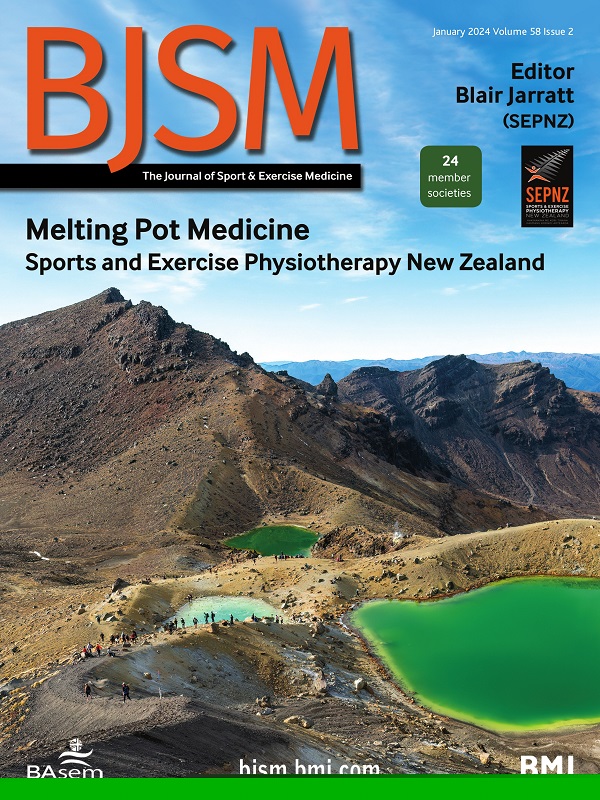利用动态任务中获得的2D视频测量数据预测女运动员的继发性ACL损伤:一项回顾性病例对照研究
IF 16.2
1区 医学
Q1 SPORT SCIENCES
引用次数: 0
摘要
目的探讨动态任务中基于视频的二维角度测量能否预测女运动员ACL重建(ACLR)后的继发性前交叉韧带(ACL)损伤。方法对女运动员aclr术后重返运动前的6项任务(下步、落跳、侧步、减速、三级跳和侧步切)进行2D录像评估。恢复运动后通过调查确定再损伤状态(N=345)。非接触性ACL再损伤(n=23)与非受伤运动员(n=57)进行匹配。从2D视频中测量了5个已知的原发性ACL损伤危险因素(躯干-胫骨角、大腿角、躯干倾斜、骨盆倾斜、额平面投影角(FPPA))。使用受试者工作特征曲线确定2D角度的再损伤截止点,并计算每个2D替代点的综合得分,得分越高表明在更多任务中高风险移动。Logistic回归,调整混杂因素,评估每个综合评分的ACL再损伤风险。逐步回归确定了最强的2D预测因子。结果校正混杂因素后,5个2D替代评分中有4个独立预测ACL再损伤。对于运动员表现出高风险运动的每一项额外任务,再损伤的几率增加:躯干-胫骨角复合评分(表示膝关节伸肌相对于髋关节伸肌力矩增加;OR 1.75; 95% CI 1.24至2.47;p=0.001),大腿角复合评分(表示垂直地面反作用力增加;OR 1.69, 95% CI 1.14至2.50,p=0.01), FPPA复合评分(表示膝关节外翻力矩增加;OR 2.29, 95% CI 1.13 ~ 4.65, p=0.02)和骨盆倾斜综合评分(表示骨盆下降增加;OR 1.85, 95% CI 1.16 ~ 2.95, p=0.01)。选择躯干-胫骨角综合评分作为最强预测因子。结论已知的三维危险因素的二维替代物可以预测继发性ACL损伤。这些发现支持开发一种基于2D视频测量的运动评估,为ACLR后的重返运动决策提供信息,并识别有风险的运动员。如有合理要求,可提供资料。如通讯作者提出合理要求,可提供数据。本文章由计算机程序翻译,如有差异,请以英文原文为准。
Prediction of secondary ACL injury in female athletes using 2D video-based measurements obtained during dynamic tasks: a retrospective case–control study
Objective To determine if two-dimensional (2D) video-based angular measurements obtained during dynamic tasks predict secondary anterior cruciate ligament (ACL) injury in female athletes post-ACL reconstruction (ACLR). Methods Female athletes post-ACLR underwent 2D video assessment during six tasks (step down, drop jump, lateral shuffle, deceleration, triple hop and side-step-cut) before returning to sport. Reinjury status was determined via survey after returning to sport (N=345). Non-contact ACL reinjuries (n=23) were matched to non-injured athletes (n=57). Five 2D video-based surrogates of known risk factors for primary ACL injury (trunk-tibia angle, thigh angle, trunk lean, pelvis tilt, frontal plane projection angle (FPPA)) were measured from 2D videos across tasks. Reinjury cut-offs for the 2D angles were determined using receiver operating characteristic curves, and composite scores were calculated for each 2D surrogate, with higher scores indicating a high-risk movement across more tasks. Logistic regression, adjusted for confounders, assessed ACL reinjury risk for each composite score. Stepwise regression identified the strongest 2D predictor. Results Four of five 2D surrogate composite scores independently predicted ACL reinjury after adjusting for confounders. For each additional task in which an athlete demonstrated a high-risk movement, the odds of reinjury increased: trunk-tibia angle composite score (representing increased knee extensor relative to hip extensor moments; OR 1.75; 95% CI 1.24 to 2.47; p=0.001), thigh angle composite score (representing increased vertical ground reaction forces; OR 1.69, 95% CI 1.14 to 2.50, p=0.01), FPPA composite score (representing increased knee valgus moments; OR 2.29, 95% CI 1.13 to 4.65, p=0.02) and pelvis tilt composite score (representing increased pelvis drop; OR 1.85, 95% CI 1.16 to 2.95, p=0.01). The trunk-tibia angle composite score was selected as the strongest predictor. Conclusions 2D surrogates of known three-dimensional risk factors for primary ACL injury can predict secondary ACL injury. These findings support developing a movement assessment using 2D video-based measurements to inform return to sport decisions and identify at-risk athletes following ACLR. Data are available on reasonable request. Data are available on reasonable request from the corresponding author.
求助全文
通过发布文献求助,成功后即可免费获取论文全文。
去求助
来源期刊
CiteScore
27.10
自引率
4.90%
发文量
217
审稿时长
3-8 weeks
期刊介绍:
The British Journal of Sports Medicine (BJSM) is a dynamic platform that presents groundbreaking research, thought-provoking reviews, and meaningful discussions on sport and exercise medicine. Our focus encompasses various clinically-relevant aspects such as physiotherapy, physical therapy, and rehabilitation. With an aim to foster innovation, education, and knowledge translation, we strive to bridge the gap between research and practical implementation in the field. Our multi-media approach, including web, print, video, and audio resources, along with our active presence on social media, connects a global community of healthcare professionals dedicated to treating active individuals.

 求助内容:
求助内容: 应助结果提醒方式:
应助结果提醒方式:


